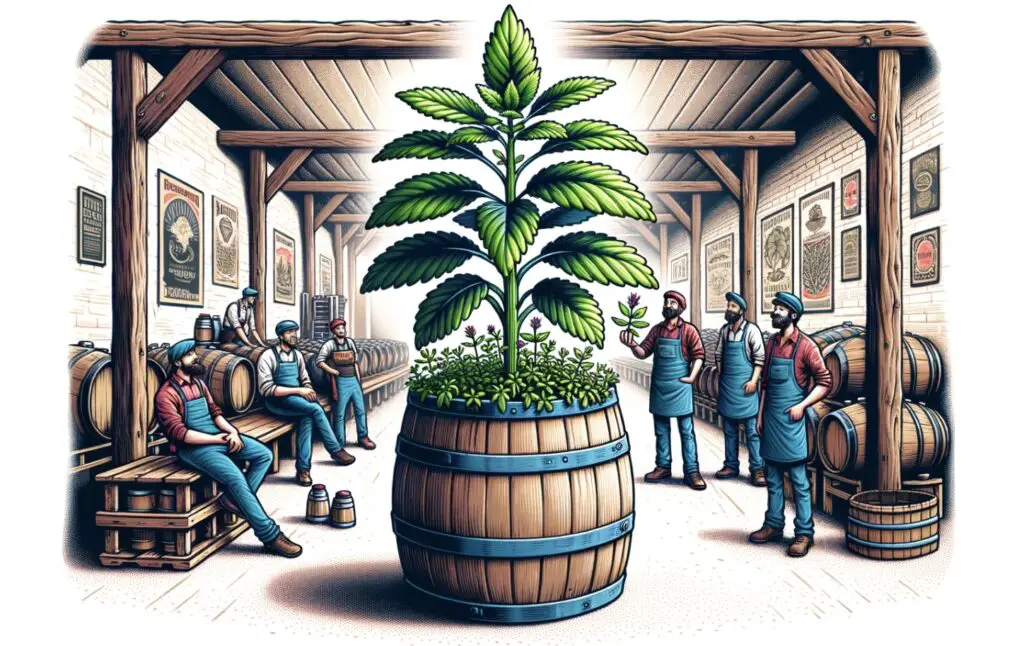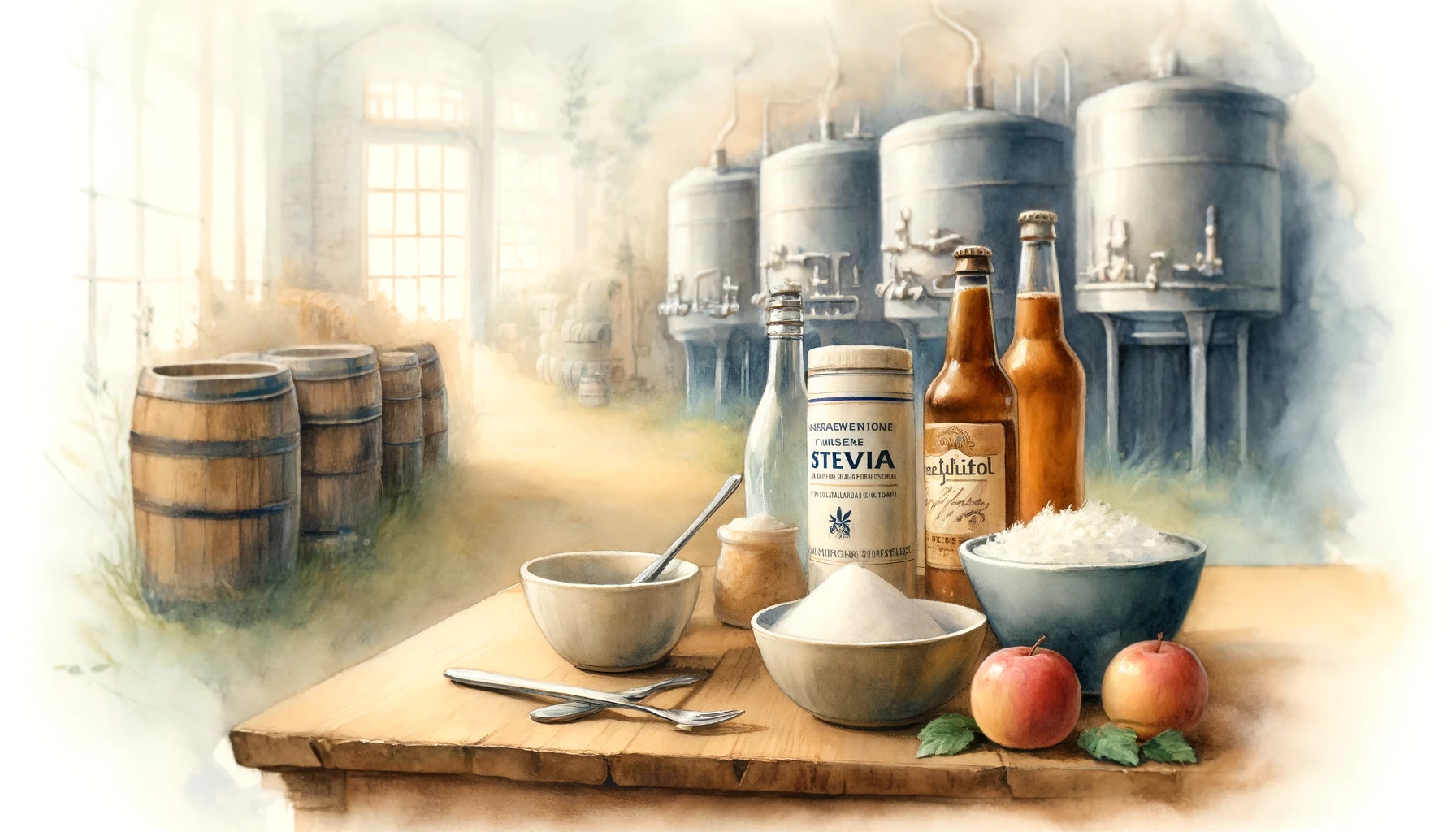Looking to add a touch of sweetness to your cider without worrying about over-fermentation?
Non-fermentable sweeteners may be the perfect solution for you.
We explore the benefits of using non-fermentable sweeteners in cider brewing, the best options available, and how to incorporate them into your brewing process.
These sweeteners offer advantages for cider makers, from balancing flavors to avoiding over-fermentation. Find out the top 5 non-fermentable sweeteners for cider brewing and some helpful tips for using them effectively.
What Are Non-fermentable Sweeteners?
.jpg_00.jpeg)
Non-fermentable sweeteners are sugar substitutes that do not undergo fermentation during the cider brewing process. These additives provide sweetness without contributing to the fermentation process, making them ideal for enhancing the flavor of ciders.
Their distinct feature lies in their inability to be converted into alcohol by the yeast used in brewing, ensuring that the sweetness remains intact. This characteristic is particularly crucial in cider making, as it allows brewers to control the final taste profile without altering the alcohol content.
It’s important to note the difference between natural non-fermentable sweeteners like stevia and artificial ones such as saccharin, each offering unique flavor profiles and sweetness levels.
Why Use Non-fermentable Sweeteners in Cider Brewing?
The use of non-fermentable sweeteners in cider brewing serves multiple purposes, including balancing the flavor profile, increasing sweetness levels, and preventing over-fermentation, which can impact the final taste and alcohol content of the cider.
Incorporating non-fermentable sweeteners can provide a more stable fermentation process, leading to a consistent and predictable outcome. By adding these sweeteners, cidermakers have greater control over the sweetness levels without worrying about excessive alcohol production. This control over fermentation helps maintain the desired flavor profile and ensures that the cider retains its intended characteristics. The strategic use of non-fermentable sweeteners in cider brewing offers a versatile tool for achieving a well-balanced and high-quality final product.
To Balance the Flavor
One key reason for using non-fermentable sweeteners in cider brewing is to balance the flavor profile of the cider. By adding these sweeteners, cider makers can adjust the taste to achieve the desired balance of sweetness and acidity.
This balance is crucial in creating a harmonious drinking experience, where the sweetness complements the natural tartness of the apples without overpowering it.
Examples of non-fermentable sweeteners commonly used in cider brewing include sucralose, stevia, and erythritol. These sweeteners are chosen for their ability to enhance the flavor of the cider without contributing additional sugars that could ferment during the brewing process.
The right choice and proportion of sweetener can elevate a cider from being just good to exceptional, capturing a perfect blend of flavors for cider enthusiasts to enjoy.
To Increase Sweetness
Another reason for utilizing non-fermentable sweeteners in cider brewing is to increase the sweetness level without introducing additional fermentable sugars. This allows cider makers to achieve the desired level of sweetness in the final product.
Non-fermentable sweeteners play a crucial role in enhancing the overall taste profile of ciders by providing a consistent sweetness that remains unchanged during fermentation. By incorporating these sugar substitutes, cider makers can control the sweetness without impacting the alcohol content. To optimize sweetness, various techniques such as blending different sweeteners, adjusting the ratio of sweeteners to acidity, and balancing flavors through trial and error are employed. This precise manipulation ensures that the cider maintains a harmonious balance of sweetness and acidity, appealing to a wide range of consumer preferences.
To Avoid Over-fermentation
Non-fermentable sweeteners are employed in cider brewing to prevent over-fermentation by providing a source of sweetness that does not contribute to the fermentation process. This helps maintain control over the fermentation rate and final alcohol content.
The role of sweetening agents in managing fermentation is crucial in ensuring a balanced and controlled brewing process. By using non-fermentable sweeteners, cider makers can manipulate the sweetness levels without affecting the alcohol content. This strategic use of sweetening agents allows for a more precise control of the fermentation process, resulting in a desired flavor profile and alcohol level in the final product. Choosing the right non-fermentable sweeteners and employing them effectively can significantly impact the quality of the cider, providing a versatile tool for brewers to craft unique and consistent beverages.
What Are the Best Non-fermentable Sweeteners for Cider Brewing?
When it comes to selecting the best non-fermentable sweeteners for cider brewing, several options stand out, including stevia, erythritol, xylitol, monk fruit extract, and sucralose. These sweeteners offer low-calorie solutions for sweetening ciders without affecting fermentation.
- Stevia, known for its intense sweetness derived from the steviol glycosides present in the stevia leaf, is a popular choice among cider makers looking to avoid added sugars.
- Erythritol, a sugar alcohol with zero net calories and no impact on blood sugar levels, provides a pleasant cooling effect in ciders.
- Xylitol, another sugar alcohol, adds a natural sweetness similar to sucrose but with fewer calories.
- Monk fruit extract, derived from the Siraitia grosvenorii plant, offers a unique sweetness without the bitter aftertaste sometimes associated with artificial sweeteners.
Stevia
Stevia is a popular non-fermentable sweetener choice for cider brewing due to its natural origin and high sweetness potency. It provides a low-calorie alternative to sugar while enhancing the sweetness of ciders.

Its sweetness potency is much greater than that of sugar, allowing for the use of smaller quantities to achieve the desired level of sweetness in cider recipes. This makes stevia a cost-effective option for cider makers looking to reduce their sugar intake while still enjoying a sweet taste.
When incorporating stevia into cider recipes, it is important to consider its impact on flavor profile. Stevia can have a slightly different taste compared to sugar, so experimentation with varying amounts is key to finding the right balance in your cider formulation.
Erythritol
.jpg_01.jpeg)
Erythritol is a sugar alcohol that serves as an excellent non-fermentable sweetener for cider brewing. It delivers sweetness without contributing to fermentation, making it a versatile option for cider makers.
By using erythritol in cider production, brewers can control the sweetness levels more precisely compared to traditional sugars, as erythritol provides a clean, neutral sweetness without any aftertaste. This allows for a balanced taste profile in ciders while also reducing the calorie content. When incorporating erythritol, it is recommended to use it in a ratio of 1:1 with sugar to achieve the desired sweetness. This ratio ensures that the sweetness is maintained, and the overall flavor of the cider is not compromised.
Xylitol
Xylitol is a sugar alcohol commonly employed as a non-fermentable sweetener in cider brewing. Known for its sweetness and low-calorie nature, xylitol offers cider makers a reliable option for sweetening their creations.
It provides a clean and crisp sweetness to ciders without contributing to additional fermentation, making it particularly useful for crafting dry ciders. When incorporated into cider recipes, xylitol can enhance the overall flavor profile by balancing out acidity and imparting a subtle mouthfeel. It’s essential to be mindful of the quantity used, as excessive xylitol can potentially lead to gastrointestinal discomfort. It is recommended to carefully measure and gradually increase the amount of xylitol to avoid over-sweetening or causing fermentation issues.
Monk Fruit Extract
Monk fruit extract is a natural sweetener that has gained popularity in cider brewing for its intense sweetness and zero-calorie content. This sweetener offers a natural alternative for those seeking to sweeten their ciders without affecting fermentation.
Monk fruit extract brings a unique flavor profile to ciders, characterized by a subtle fruity undertone that complements the apple notes. When incorporated into cider recipes, it enhances the overall taste without overpowering the natural flavors. One key advantage is that monk fruit extract dissolves easily and blends well with other ingredients, making it convenient to use in different cider brewing processes. Not only does it add sweetness, but it also contributes to a more balanced and nuanced flavor profile in the final product.
Sucralose
Sucralose, an artificial sweetener, is a popular choice for cider brewing due to its high sweetness intensity and low-calorie properties. It offers cider makers a reliable option to enhance sweetness without affecting fermentation.
When using sucralose in cider production, it is crucial to carefully consider the dosage for optimal results. Generally, a small amount of sucralose can go a long way in sweetening cider, with just a few drops being enough to provide a significant sweetness boost.
Over-sweetening can detract from the natural flavors of the cider, so it is advised to start with a conservative amount and adjust gradually. Sucralose may introduce a slightly different flavor profile compared to traditional sugars, so experimentation is key to finding the perfect balance and ensuring a delicious end product.
How to Use Non-fermentable Sweeteners in Cider Brewing?
Utilizing non-fermentable sweeteners in cider brewing requires precision and understanding of the sweetening agents’ impact on the final product. It involves calculating the appropriate amount, timing of addition, and methods to ensure effective incorporation.
When considering the amount of sweetener to add, you must take into account the sweetness level you desire in the finished cider, as well as the sweetness potency of the specific sweetener.
It’s crucial to refer to conversion charts or online resources to determine the equivalent sweetness of the non-fermentable sweetener compared to traditional sugars.
Timing-wise, adding the sweetener at different stages of fermentation can lead to varying levels of sweetness and aroma retention.
Experimenting with different methods of adding sweeteners, such as directly into the fermenter or incorporating them into a secondary mix, can also yield diverse flavor profiles and experiences.
Calculate the Amount Needed
Calculating the precise amount of non-fermentable sweeteners required for cider brewing is crucial to achieve the desired sweetness levels. Factors such as cider volume, sugar content, and taste preferences play a role in determining the optimal sweetener quantity.
Once you have identified the sweetener quantity needed, it’s essential to consider how to adjust the sweetness levels to achieve the perfect balance. Common methods include gradually adding small amounts of sweetener and tasting the cider as you go. This allows you to fine-tune the sweetness to your liking.
To ensure uniform sweetening throughout the batch, thorough mixing is key. Stir the sweetener into the cider mixture thoroughly, ensuring it is evenly distributed. Proper mixing helps prevent uneven sweetness levels in different parts of the batch.
Add During Secondary Fermentation
Incorporating non-fermentable sweeteners during the secondary fermentation stage of cider production allows for controlled sweetening without affecting primary fermentation processes. This timing ensures that the sweetness is preserved in the final product.
It is crucial to consider the benefits of using sweeteners at this stage, as they can enhance the overall flavor profile of the cider. By adding sweeteners during secondary fermentation, the flavors have more time to develop and blend harmoniously, resulting in a well-rounded and balanced taste. To maintain sweetness stability throughout the fermentation process, techniques such as monitoring sugar levels, adjusting pH levels, and controlling temperature are essential. These practices help ensure that the desired level of sweetness is achieved while maintaining the integrity of the cider’s flavor.
Mix with Priming Sugar
.jpg_10.jpeg)
Combining non-fermentable sweeteners with priming sugar during bottling can enhance the flavor complexity of ciders while ensuring consistent carbonation levels. This method offers a balanced approach to sweetening and carbonation control.
By adding non-fermentable sweeteners like stevia or erythritol along with priming sugar, cider makers can achieve a desired level of sweetness without risking over-fermentation. The careful balance of these ingredients plays a crucial role in developing a well-rounded flavor profile.
When bottling with sweeteners and priming sugar, it is important to consider the impact on carbonation. Proper calculations and measurements are essential to avoid under-carbonation or excessive fizziness. Monitoring the conditioning process closely helps maintain the ideal carbonation levels for a delightful cider drinking experience.
What Are the Safety Precautions When Using Non-fermentable Sweeteners?
While non-fermentable sweeteners offer benefits in cider brewing, it is essential to observe safety precautions to avoid potential issues. These include using appropriate sweetener quantities, being mindful of allergies, and ensuring proper handling and storage of sweetening agents.
- Dosage control is crucial when incorporating non-fermentable sweeteners into cider recipes, as using too much can result in overly sweet or unbalanced flavors.
- Allergy awareness is also vital, as certain sweeteners may trigger reactions in sensitive individuals.
Best practices for managing sweetener-related risks involve clearly labeling containers, storing sweeteners away from contaminants, and following recommended guidelines for their use in cider making.
Do Not Use Too Much
One crucial safety precaution when using non-fermentable sweeteners in cider brewing is to avoid excessive quantities that can lead to overpowering sweetness or off-flavors. Moderation in sweetener usage is key to maintaining the desired taste balance.
This precaution is essential because an overabundance of sweeteners can not only mask the natural flavors of the cider but also pose potential health risks. High levels of sweetening agents can disrupt the fermentation process, resulting in an unbalanced and overly sweet final product. To ensure optimal cider quality, it is important to carefully measure and adjust sweetener levels according to the recipe guidelines.
Utilizing natural sweeteners like honey or maple syrup can enhance the complexity of flavors without the need for excessive amounts.
Be Aware of Any Allergies
When incorporating non-fermentable sweeteners in cider brewing, it is important to be cognizant of potential allergies to specific sweetening agents. Checking for allergens and informing consumers about the sweeteners used can help prevent adverse reactions.
Common sweetener allergens to be mindful of include ingredients like honey, molasses, and corn syrup, which are often used in cider production. To address allergy concerns effectively, cider producers should thoroughly review their sweetener sources, opt for allergen-free alternatives whenever possible, and clearly label all sweeteners on the packaging.
By promoting allergen awareness and transparency, cider makers can enhance consumer trust and cater to individuals with varying dietary restrictions or sensitivities.
What Are Some Tips for Using Non-fermentable Sweeteners in Cider Brewing?
To optimize the use of non-fermentable sweeteners in cider brewing, it is beneficial to experiment with different sweetener combinations, conduct taste tests before bottling, and maintain accurate records of the sweetener quantities used. These tips can help cider makers achieve the desired sweetness and flavor profile in their creations.
Blending various non-fermentable sweeteners such as stevia, erythritol, or monk fruit can enhance complexity and depth of flavors in the cider. When conducting sensory evaluations, consider factors like sweetness intensity, aftertaste, and overall mouthfeel. Keeping detailed logs of sweetener types and proportions allows for easier replication of successful batches. By tracking sweetener usage meticulously, you can fine-tune recipes and ensure consistency in your cider production process, leading to reliable results and satisfied drinkers.
Experiment with Different Combinations
One useful tip for using non-fermentable sweeteners in cider brewing is to experiment with various sweetener combinations to discover unique flavor profiles and sweetness levels. By blending different sweeteners, cider makers can create customized recipes that cater to diverse taste preferences.
This experimentation with sweetener combinations opens up a world of possibilities in terms of flavor diversity and the creative potential in cider making. Whether it’s pairing honey with maple syrup or agave nectar with stevia, the blending of multiple sweetening agents adds layers of complexity to the taste profile of the final product.
Not only does this allow for a more nuanced and well-rounded flavor experience, but it also presents an opportunity for cider enthusiasts to showcase their unique style and innovative approach to crafting exceptional beverages.
Taste Test Before Bottling
Prior to bottling, it is advisable to conduct taste tests using non-fermentable sweeteners to ensure the desired sweetness levels and flavor balance. This step allows cider makers to make adjustments and fine-tune the sweetness before final packaging.
Sensory evaluation plays a pivotal role in cider production as it helps in assessing the quality of the product. Taste testing, in particular, is crucial for ensuring that the cider meets the desired flavor profile and sweetness level.
By engaging in sensory analysis, cider makers can gather valuable feedback on how different elements like acidity, tartness, and sweetness are perceived by consumers. Conducting effective taste tests involves using a diverse panel of tasters to capture a range of preferences and experiences. It also involves setting clear criteria for evaluating sweetness, ensuring consistency in testing conditions, and recording detailed feedback for future reference.
Keep Track of Amounts Used
.jpg_11.jpeg)
Maintaining detailed records of the non-fermentable sweetener quantities used in cider recipes is essential for consistency and recipe reproducibility.
This careful documentation also plays a crucial role in ensuring that the final product consistently meets quality standards and customer expectations. By recording sweetener data accurately, cider producers can identify patterns in ingredient usage, evaluate the impact of different sweeteners on flavor profiles, and make informed decisions for recipe adjustments. Accurate tracking of sweetener quantities facilitates troubleshooting potential issues that may arise during the cider-making process, leading to a more efficient production workflow and higher product satisfaction levels.
Frequently Asked Questions
What are the 5 best non-fermentable sweeteners for cider brewing?
The 5 best non-fermentable sweeteners for cider brewing are honey, maple syrup, agave nectar, stevia, and erythritol.
Why should I use non-fermentable sweeteners in cider brewing?
Non-fermentable sweeteners are used in cider brewing to add sweetness without affecting the fermentation process. This allows for a more consistent end product.
What makes honey a great non-fermentable sweetener for cider brewing?
Honey not only adds sweetness to cider but also adds unique flavors depending on the type of honey used. It also has antimicrobial properties that can help prevent spoilage during fermentation.
Can maple syrup be used as a non-fermentable sweetener in cider brewing?
Yes, maple syrup is a great non-fermentable sweetener for cider brewing. It adds a rich, caramel-like sweetness and also contains minerals that can benefit the fermentation process.
Are there any health benefits to using non-fermentable sweeteners in cider brewing?
Yes, some non-fermentable sweeteners like stevia and erythritol are low in calories and have a low glycemic index, making them a healthier alternative to traditional sugar in cider brewing.
Can I use non-fermentable sweeteners in place of sugar in cider brewing?
Yes, non-fermentable sweeteners can be used as a substitute for sugar in cider brewing. Just be sure to adjust the amount used according to the sweetness level desired.





Leave a Reply
You must be logged in to post a comment.